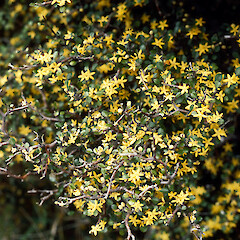Corokia cotoneaster
Common name
korokio, wire-nettting bush
Family
Argophyllaceae
Flora category
Vascular – Native
Endemic taxon
Yes
Endemic genus
No
Endemic family
No
Structural class
Trees & Shrubs - Dicotyledons
NVS code
The National Vegetation Survey (NVS) Databank is a physical archive and electronic databank containing records of over 94,000 vegetation survey plots - including data from over 19,000 permanent plots. NVS maintains a standard set of species code abbreviations that correspond to standard scientific plant names from the Ngä Tipu o Aotearoa - New Zealand Plants database.
CORCOT
Chromosome number
2n = 18
Current conservation status
The conservation status of all known New Zealand vascular plant taxa at the rank of species and below were reassessed in 2017 using the New Zealand Threat Classification System (NZTCS) – more information about this can be found on the NZTCS website. This report includes a statistical summary and brief notes on changes since 2012 and replaces all previous NZTCS lists for vascular plants.
Please note, threat classifications are often suggested by authors when publications fall between NZTCS assessment periods – an interim threat classification status has not been assessed by the NZTCS panel.
- Conservation status of New Zealand indigenous vascular plants, 2017 . 2018. Peter J. de Lange, Jeremy R. Rolfe, John W. Barkla, Shannel P. Courtney, Paul D. Champion, Leon R. Perrie, Sarah M. Beadel, Kerry A. Ford, Ilse Breitwieser, Ines Schönberger, Rowan Hindmarsh-Walls, Peter B. Heenan and Kate Ladley. Department of Conservation. Source: NZTCS and licensed by DOC for reuse under the Creative Commons Attribution 4.0 International licence.
2017 | Not Threatened
Previous conservation statuses
2012 | Not Threatened
2009 | Not Threatened
2004 | Not Threatened
Brief description
Common variable shrub with zig-zag thin grey twigs bearing clusters of small leaves that are white underneath with a dented or rounded tip and on a dark flattened leaf stalk. Flowers yellow, star-shaped. Fruit red.
Distribution
North, South and Three Kings Islands.
Habitat
Lowland shrubland, river-flats and rocky places throughout.
Wetland plant indicator status rating
Information derived from the revised national wetland plant list prepared to assist councils in delineating and monitoring wetlands (Clarkson et al., 2021 Manaaki Whenua – Landcare Research Contract Report LC3975 for Hawke’s Bay Regional Council). The national plant list categorises plants by the extent to which they are found in wetlands and not ‘drylands’. The indicator status ratings are OBL (obligate wetland), FACW (facultative wetland), FAC (facultative), FACU (facultative upland), and UPL (obligate upland). If you have suggestions for the Wetland Indicator Status Rating, please contact: [Enable JavaScript to view protected content]
UPL: Obligate Upland
Rarely is a hydrophyte, almost always in uplands (non-wetlands).
Detailed description
Much-branched shrub up to 3 m or more tall. Branchlets rigid, divaricate; bark dark, rough. Leaves of seedlings obovate-spathulate, often elongate and 3-lobed. Leaves of adults varying in size according to exposure, alternate or in alternate fascicles, obovate-cuneate to obovate-oblong to suborbicular, obtuse, emarginate or not; lamina dark or coppery green above, silvery white beneath, 2-15 x 2-10 mm, on flattened petiole up to 20 mm long. Flowers axillary and terminal, solitary or in fascicles of 2-4; 5-8 mm diameter, numerous per plant. Calyx-segments 1-1.5 mm long, ovate-triangular, pubescent on backs; petals bright yellow, usually 5, approximately 4-5 mm long, narrow oblong-ovate, acute to subacute, pubescent on backs. Drupes red or orange or yellow, 5-8 mm long.
Similar taxa
Helichrysum lanceolatum can closely resemble Corokia in the absence of flowers or fruit. Helichrysum lacks the distinctive zigzagging of stiff, dark branchlets, and has paler green, duller, thinner leaves with pointed rather than blunt or indented tips.
Olearia odorata has opposite leaves or leaf clusters and fluffy seeds.
Olearia capillaris has wavy or crinkle-cut edges to the leaves, fawn, peeling bark, and fluffy seeds.
Olearia polita has opposite leaves or leaf clusters, two ridges (lens helpful) along the young branchlets, and fluffy seeds.
Flowering
(September-) October-December (-April)
Flower colours
Yellow
Fruiting
February-May (-September)
Life cycle
Fleshy drupes are dispersed by frugivory (Thorsen et al., 2009).
Etymology
corokia: From the Maori name korokio or korokia-tarango
cotoneaster: from Latin cotneum, meaning 'quince', and the suffix -aster meaning 'imperfectly resembling'.
TAXONOMIC NOTES
Corokia is a small genus of three species occurring naturally only in New Zealand. C. cotoneaster hybridises with the larger leaved C. buddleioides where the two species grow together, and some of the hybrid forms are popular as garden plants.
Attribution
Description adapted by M. Ward from Allan (1961) and Wilson & Galloway (1993).
References and further reading
Allan, H. H. 1961. Flora of New Zealand. Vol. 1. Wellington: Government Printer. pg. 441.
Moorfield, J. C. (2005). Te aka : Maori-English, English-Maori dictionary and index. Pearson Longman: Auckland, N.Z.
Thorsen, M. J.; Dickinson, K. J. M.; Seddon, P. J. 2009. Seed dispersal systems in the New Zealand flora. Perspectives in Plant Ecology, Evolution and Systematics 11: 285-309.
Wilson, H. D., & Galloway, T. 1993. Small-leaved shrubs of New Zealand. Manuka Press. pg. 182-184.


























